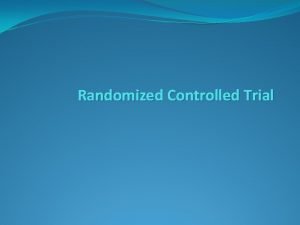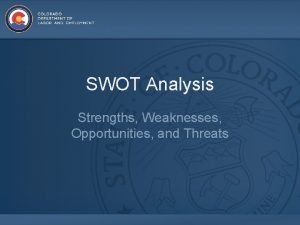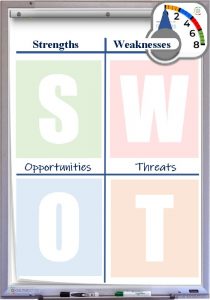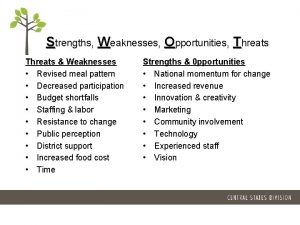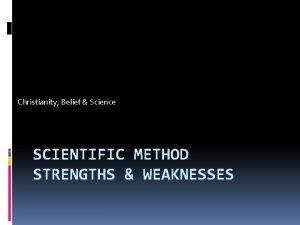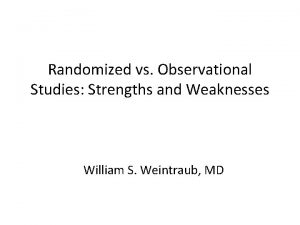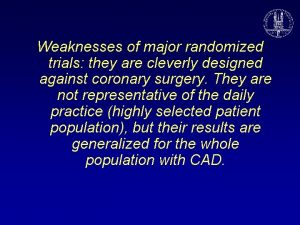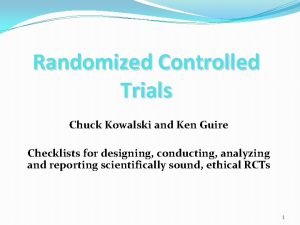Randomized Controlled Trials STRENGTHS WEAKNESSES AND POLICY RELEVANCE















- Slides: 15

Randomized Controlled Trials STRENGTHS, WEAKNESSES AND POLICY RELEVANCE

Intended Contributions and Mandate The discussion of aid evaluation and evidence based development policy. How randomized controlled trials (RCT) can contribute to our understanding of impact. Discuss the use of RCT in Swedish aid context.

Background on aid evaluation Process evaluation Impact evaluation Design, implementation, output Impact on target group

Background School building project Output: # schools built Impact: performance of school children Causal impact?

Randomized Controlled Trials I. The methodology randomly assigns subjects to treatment and control status, and then implements the intervention only in the treatment subset. II. A baseline study maps out conditions in both subgroups before the intervention. III. An endline study maps out conditions in both subgroups after the intervention. IV. Impact is estimated as the difference in conditions before and after the intervention in the treatment group, relative to the same difference in the control group (diff-in-diff).

Applications Conditional Cash Transfers Microfinance Public Service Provision Political Accountability and Corruption Self Help Groups

Strengths and Weaknesses External validity • Place • Provider • Scale Selection • Interventions • Outcomes • Confirmation bias Ethics • Local information • Preliminary results • Control group Resource requirements • Planning • Time • Skills

Policy purposes Evidence based development policy: Learning for future aid strategy. Evaluate impact as part of responsibility to evaluate and monitor government spending. The relative importance of strengths and weaknesses discussed above partly depends on this purpose.

In Sum RCT is a very useful methodology in the right circumstances, but it can only be one of several tools in the toolbox.

RCTs and Swedish aid evaluation? Weaknesses in Swedish • Imbalance in relative focus on process and impact. • Lack of quantitative methods to evaluate impact. aid evaluation. Sida has not yet commissioned any RCTs on any of their own projects and programs.

Emphasis on results Paris Declaration Swedish political statements and guidelines (resultatstrategier) Donors such as DIFID, USAID and World Bank. Incorporating RCTs into the Swedish evaluation toolbox is a concrete and credible opportunity for the Swedish aid community to signal that it takes impact and the quality of evaluations seriously.

Benefits? 1. Getting a better estimate of impact of specific projects and general types of interventions. 2. Strengthening the reputation of Sweden as a leading donor country in the forefront of project and program development. 3. Lending some discipline to the process of project and program planning (well defined objectives, requires baselines, definition of measurable outcomes).

Suggestions Make systematic use of existing results from high quality impact evaluations, and make sure that those who make decisions on the allocation of spending have access to, and capacity to critically asses, these results. Develop the necessary competence to procure RCTs in-house. Make sure that partner country representatives and implementing organizations are on board.

Glass half full? Often easier to improve when you have fallen behind, as long as there is a will to change. Competence exists nationally and internationally, and I sense an increased interest in collaboration with the academic community from Sida. Opportunities to combine building competence and direct development assistance exist.

Why credible impact assessment matters. We know from first hand experience that foreign aid can contribute to employment, income and welfare in donor countries. We need to make sure that this is true also for those we are trying to help in the partner countries.
 Advantage of randomized controlled trial
Advantage of randomized controlled trial Sanction behind directive principles
Sanction behind directive principles Johnson & johnson swot
Johnson & johnson swot Marks and spencer strengths and weaknesses
Marks and spencer strengths and weaknesses British strengths and weaknesses
British strengths and weaknesses Strengths of the confederacy
Strengths of the confederacy North and south strengths and weaknesses chart
North and south strengths and weaknesses chart Glanzer and cunitz strengths and weaknesses
Glanzer and cunitz strengths and weaknesses Mbti strengths and weaknesses
Mbti strengths and weaknesses Interaction model of curriculum development
Interaction model of curriculum development Ventura psw
Ventura psw Strengths and weaknesses of token economy
Strengths and weaknesses of token economy Articles of confederation strengths
Articles of confederation strengths Plaafp strengths and weaknesses examples
Plaafp strengths and weaknesses examples Pnp swot analysis example
Pnp swot analysis example 3 strengths and weaknesses
3 strengths and weaknesses
